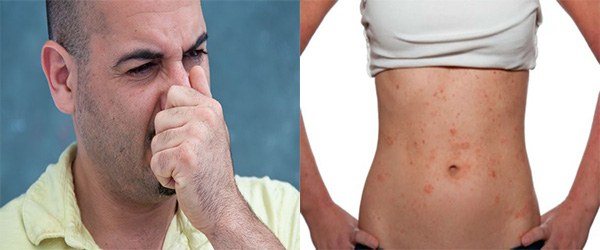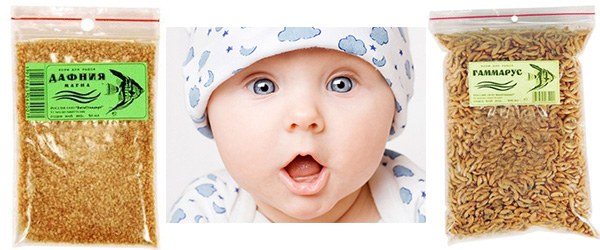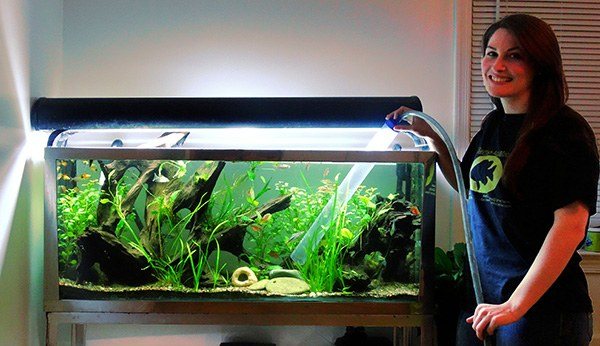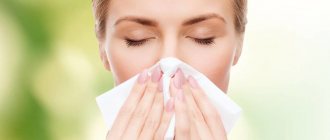Allergies to aquarium fish are rare. People who have direct contact with fish food are most susceptible to developing the disease. The fish themselves living in the aquarium, as a rule, rarely cause allergic reactions. This is due to the fact that their waste products do not enter the air and do not have direct contact with human skin.
Therefore, food is the strongest allergen, especially if it is manufactured with violations of the technological process. The nutritional mixture contains protein components, which are the strongest provocateurs of an allergic reaction.
In addition, the water in the aquarium and the installed filters accumulate protein food residues, so an allergy even to aquarium water automatically becomes possible.
Causes of allergies
There are very few reasons for developing an allergy to fish.
- The leading role belongs to protein structures, usually of animal origin. These include a dry substance for feeding fish, which can be rubbed between your fingers. As a result, a large amount of dust spreads in the air, causing allergic symptoms in people.
- The second factor in the development of the disease is the aquarium water into which these proteins enter. When they come into contact with the skin, they cause negative manifestations.
Causes of allergies when keeping an aquarium at home
Dry food for aquarium fish is a strong irritant.
An allergy to fish is possible. For some patients, the smell of fish is enough for doctors to perform resuscitation measures to save the person. But such a reaction is rare.
Dry fish food is considered a strong allergen. It is made from dried small crustaceans. More often, aquarium fish are fed with crustaceans such as daphnia and gammarus. The crushed dry shells of crustaceans harbor microscopic mites and fungi, which provoke clinical manifestations of the disease in allergy sufferers.
The remains of dry food in the aquarium quickly rot and spoil the water. Hungry fish may swallow dry food that has not had time to soak. It swells in the intestines of fish, causing indigestion. Therefore, before feeding, it is recommended to grind dry food to dust: small particles quickly become wet, are readily eaten by fish and are easily digested. Dust from feed gets on the mucous membranes or in the respiratory tract and causes an allergic reaction.
An excellent substrate for the growth of mold fungi is moist soil or leftover food in an aquarium. Mold is one of the common irritants for people prone to allergies. Evaporation from contaminated water that does not change for a long time can also cause allergic lacrimation or other symptoms. Aeroallergens cause a response from the immune system.
Irritants can be the biological components of the feed included in its composition.
The response of the immune system is caused by slugs living in the aquarium. The mucus of some species of snails contains biological elements that provoke atopy.
General allergic symptoms
There are a number of indicators, the presence of which may be an indicator of the development of allergies. The main symptoms appear:
- cough and sore throat;
- irritation of the mucous membranes of the oral cavity;
- development of allergic rhinitis and conjunctivitis;
- sore nose and frequent sneezing;
- hyperemic rash all over the body;

- difficulty breathing;
- wheezing may occur in the lungs;
- a sharp rise in body temperature.
When an allergy to aquarium fish food develops, it can be expressed by one symptom or be completely asymptomatic. In addition, the difference in the course of allergic symptoms among age groups and especially among children should not be neglected.
In children aged 4-6 years, the development of allergies can be complicated, and in adult patients it can develop latently.
Clinical manifestations of atopy
An allergy to fish food manifests itself with clear symptoms. They can occur in both children and adults. In any case, the signs should not be ignored as the condition can quickly worsen.
There are different symptoms, and they depend on how the antigen entered the body. A number of the most characteristic manifestations can be identified that appear within several hours after contact with the antigen.
Signs:
- Watery eyes, redness of the conjunctiva.
- Sinus congestion, sneezing, severe runny nose.
- Hives, redness of the skin, severe itching.
- Coughing and sneezing.
- Attacks of suffocation.
- High body temperature.
Similar signs are often observed with allergies caused by fish in an aquarium. Even if only a few symptoms are present, you will still need to see a doctor. He will make an accurate diagnosis and also give advice on further therapy.
Course of allergies in children
All parents worry if their child complains of feeling unwell, coughing, redness and swelling. Some allergens can cause an attack of suffocation, which requires urgent hospitalization of the child.
Very often, parents do not suspect that these symptoms occur in children on regular aquarium fish food. The most common provocateur is a dry mixture of daphnia and gammarus.

Sometimes, to avoid allergic symptoms, it is enough to simply replace this food by switching to live or granular. The room in which the aquarium is located needs to be cleaned more often.
And, of course, you should consult with an allergist who will give recommendations on keeping fish so as not to risk the child’s health.
allergy to fish
Some parents are sure that animals in the house cause only problems: feeding, cleaning, taking them out for walks. Others argue that a child simply needs pets for normal development. Let's try to understand the issue of the influence of pets on children
, evaluate all the pros and cons.
Having animals in the house develops a sense of responsibility in children and disciplines them. Having a pet will undoubtedly bring changes to your child's daily routine. Along with other household responsibilities, the following will be added: regular feeding, walks and other care for the animal - depending on its needs. And even fish in an aquarium require constant attention. Taking care of your pet disciplines a young person and teaches him not only to take, but also to give.
A teenager who has animals at home will never mock them because he understands and feels their pain. Of course, there are also exceptions to this rule, but they are rare and are usually associated with psychopathology or redirected aggression: if a child is beaten by his parents, he will beat his dog or cat, which depends on him as he does on his parents.
Much depends on the attitude of adults towards animals - children copy their behavior. If parents accept a puppy or kitten as a new member of the family, then it will become a friend for the child, but if the animal exists as a piece of furniture, then the child will quickly learn indifference and cruelty towards any living creature.
However, very often the care of animals falls on the shoulders of parents, who will more than once regret their lack of foresight. There are also those who deliberately do not allow children to care for animals, believing that the child will not cope with this task. I wonder how they will develop a sense of responsibility if they are not trusted?
With animals in the house, children's communication opportunities expand. A puppy, kitten, hamster or other pet is an indispensable participant in a child’s play, and this is a very important part of the development process. Children are much more likely than adults to attribute human traits to their animal friends; they communicate with them as with their peers: they talk, they confide their secrets. In some ways, they are ideal interlocutors - in any case, ideal listeners.
For kids who lack self-confidence, a great way to boost their self-esteem is to train their dog. The knowledge that your four-legged “little brother” carries out your commands raises the child’s opinion.
Fussing with pets can, to some extent, compensate for a child’s lack of human contact, including physical contact. Love is not just words and relationships, it must necessarily be expressed in affection and touch.
Small children are often subconsciously drawn to large, furry dogs - their warm body seems to remind them of their mother. Many teenagers, on the contrary, love small dogs and other animals - their parental instinct is already vaguely beginning to awaken.
Constant communication with pets helps children grow up as thinking and feeling people, allows them to master non-verbal (non-verbal) communication skills and develops an intuitive understanding of the world. With the help of animals, the child satisfies his curiosity and feels an inextricable connection with nature.
But even here difficulties may arise. Realizing that a pet is much more noble and honest than many people, a child can become withdrawn, satisfied with communication with his pet.
Pets contribute to the intellectual and spiritual development of children. Animals are the source of the first knowledge about nature. Seeing animals, a child is drawn to them, recognizes their names, notes differences, behavioral patterns, and habits.
Animals help develop sensory abilities. No educational toy can compare with them. The child, through his senses, perceives an object: its shape, size, color, smell, spatial arrangement, movement, softness and texture of fur, etc.
Animals contribute to the development of logical thinking. Based on ideas about animals, children learn to establish relationships and interdependencies: a pussy meows at a bowl - it means it’s hungry; The ferret jumps high - he wants to play, if he hides - he hunts.
You can engage in various types of activities with animals: observation, play, work, creativity, etc. As a result, curiosity and observation are formed, and imagination develops.
In the process of communicating with their pets, the child develops a sense of beauty; he learns to see natural beauty.
In addition, the child learns to show a careful (passive) and caring (active) attitude towards the animal world as a whole. He develops the foundations of an ecological culture, which is an integral part of spiritual culture. Natural beauty encourages children to be creative. They strive to reflect their feelings for animals in children's poems, stories of their own composition and, of course, in drawings.
Animals can have therapeutic effects. Modern medicine notes that pets, as a positive emotional factor, contribute to the healing of certain cardiovascular diseases and nervous disorders. Research by foreign scientists has established that owners of cats, dogs, and parrots live 4-5 years longer than other people. Pets can alleviate any disease, and some can be completely cured. For several years now, animal therapy—the science of treatment with the help of animals—has been actively developing in the world. In the USA and Europe, special clinics are opening where furry “doctors” provide treatment. Animal-assisted therapists work in nursing homes, children's hospitals, rehabilitation centers and even the US Army, and pharmacies in the UK sell “therapeutic” white cats.
Pets strengthen the immune system. Previously, it was believed that if there is a cat or dog in the house, the child will definitely develop allergies or asthma. However, a large number of studies have proven the opposite: children raised in a home with cats or dogs have a much lower risk of developing allergies or asthma. As the British Daily Telegraph reported, children who have pets miss less school. To understand this relationship, scientists analyzed saliva samples from 138 children and determined the level of immunoglobulin in it, which is responsible for the functioning of the immune system. The presence of a cat or dog in the house makes children's bodies more actively resist infections, strengthens the immune system, and increases the level of resistance to various diseases.
According to University of Arizona (USA) biologist Esmeralda Morales, early contact with cats and dogs, contrary to popular belief, reduces the risk of allergies. “Pets expose a child to endotoxin at an early age. This contact helps the body avoid allergic diseases in the future,” writes the author of the scientific study. Thus, a child suffering from dermatitis at one year of age may not develop bronchial asthma or other allergic diseases in adulthood.
And yet no one is immune from allergies to pets. It can develop at any age. Most people who suffer from this condition often have other allergies, such as pollen or mold. This is due to hereditary reasons, so if the parents had an allergy, it may well be passed on to their children. According to research, allergies to dogs and cats affect approximately 15% of the population.
Pets are a good incentive for walking and exercise. Games with them are very popular in many families; a dog can inspire a child to jog every day and, for example, thereby help get rid of obesity.
Animals normalize blood pressure. Medications can lower blood pressure, but due to external factors (stress, tension), they cannot protect you from sudden increases. However, based on the results of monitoring a group of American brokers suffering from hypertension, it was found that those who have pets had lower blood pressure and a calmer heart rate.
Recent studies have shown that when performing a very difficult and stressful task, people who had their favorite animals with them at the time were much less stressed than those who were supported by a best friend. Perhaps this is explained by the fact that animals do not evaluate us, but simply love us.
However, Swedish scientists recommend that adults think carefully before giving their child a pet. According to recent research, a person's four-legged friends can greatly increase the likelihood that a child will start snoring as an adult.
The problem is that dogs, in the course of their life, secrete infectious bacteria, which can subsequently cause their owners to snore. The toxic substance affects the size of the tonsil glands in babies, and their enlargement is directly related to the body's tendency to snore.
Pets are a powerful source of positive emotions and an effective stress reliever. Moreover, in order to provide a child with emotional comfort, it is not necessary to have a cat or a dog - a hamster or a fluffy guinea pig is enough.
Pets lift your spirits, are able to defuse tensions in the family and smooth out conflicts - for example, a Sheppard dog will always intervene when it feels that the situation is heating up.
Teenagers growing up where there are four-legged pets, as a rule, perceive the family environment as favorable. While the vast majority of those who do not have animals believe that not everything is fine at home. Anxiety and conflict in families with animals are much lower, children are much less likely to experience feelings of inferiority, are less aggressive and more sociable. And children who have a dog cope more easily with their parents’ divorce.
But what if you love cats, and your child demands to get a dog? Or are you a fan of canary singing, but your child doesn't want to hear about anything but a guinea pig? It’s not easy to satisfy the needs of all family members!
And one more very important point. Most domestic animals have a much shorter lifespan than humans. And no one knows what the realization that his friend is no more will mean for your child.
Having a pet is a wonderful way to meet new people. For example, walking your dog will help you make more new friends, which is a good way to relieve stress. This will especially help those who are uncommunicative and shy. People will start a conversation on their own by asking about the breed or simply by observing the dog. Sometimes communication remains on the same topic, and sometimes it turns into an exciting mutual exchange of information and friendly contacts.
At what age is a child ready to take care of a pet on his own?
At the age of 6, children can already be systematically involved in caring for animals. Animals suitable for this age period: aquarium fish, birds, guinea pig, rabbit, hamster, rat. You can, for example, teach your child to wipe the outer walls of the aquarium, wash drinkers and feeders. But the child must do all this under the supervision of adults, who should focus the child’s attention on animals and their behavior. If children maintain an interest in animals, they are more willing to respond to the offer to care for them.
At 7-8 years old, a child is able to care for his pet almost independently. It will be great if you can get him not one, but several different animals, for example, aquarium fish and a budgie. This way the child will have the opportunity to make comparative observations of their behavior, and will also acquire skills in caring for different animals. You can get a cat or a dog, but you shouldn’t completely delegate the care of such a “serious” pet to a child.
At the age of 12-13, a teenager can be completely entrusted with a dog. Until this age, children need to be actively helped and, most importantly, controlled - a child is a child, he may simply forget to take a walk, and physically walking the dog several times a day can be tiring for him. By the way, this does not mean that a teenager should not be helped at all in caring for him.
Rules for feeding fish with allergies
To prevent the disease, it is important to know what food you need to purchase and what its composition is. It is necessary to exclude varieties such as daphnia and gammarus, despite their affordability and ease of use.
- There are many substitutes that are not inferior in nutritional content and vitamin complex. After opening the package, the nutritional substance should be stored in a sealed bag, without access to air;
- It is preferable to use live and frozen food (brine shrimp, plankton, coretra and bloodworms). This food is considered to be the safest for people prone to allergies. In addition, this is also of great benefit for the fish;

- Some manufacturers produce fish food in special blisters for minimal contact with human skin. Even a frozen product with increased sensitivity of a person may contain a certain amount of allergens;
- There are also dry types of food that practically do not provoke allergies, for example, granular ones;
- In addition, food in tablet form and flakes is widely available. They are almost identical in composition, but when fed with flakes, the quality of the aquarium water deteriorates. The tablets practically do not change the structure of the liquid, and they are happily eaten by fish living at the bottom.
To limit contact with possible allergens during feeding, it is necessary to give food only if the rules of self-defense are observed. You should wear gloves and use a respirator. If necessary, it is recommended to limit contact with fish waste products. Children should be especially protected, since allergic symptoms develop very quickly in them due to the immaturity of the immune system.
Symptoms of the disease
When small particles of food come into contact with the skin, they cause:
- redness, peeling and itching;
- lacrimation and sore throat occurs, a suffocating cough appears;
- a cough appears, similar to an attack of bronchial asthma;
- atopic dermatitis is observed.
It is important to remember: dry food causes more harm to children than to adults.
Children under four years of age are most difficult to tolerate the symptoms of this type of allergy. That is why, recently, in all kindergartens, “live” corners where fish and other living creatures live are being urgently eliminated. After all, the health of the child is more important than any entertainment. The protein structure of the feed is to blame. The food consists of dry daphnia and crustaceans. When thoroughly crushed, dust particles fall on the mucous membranes of the mouth and nose.
In addition to food, you should also pay attention to the soil contained at the bottom of the aquarium. If you know that one of your family members is allergic or asthmatic, stop using sand. The best option in this case would be pebbles. Small stones are convenient for fish, but will cause you trouble when changing the water. The stones will have to be thoroughly washed or even boiled, since with prolonged contact with water and as a result of their interaction with fish waste products, they tend to become covered with green mud, emitting a not entirely pleasant odor. In addition, uncleaned stones create an environment for harmful bacteria.
Rules for caring for an aquarium if you have allergies
When an allergy to an aquarium occurs, it requires special care. As a rule, with high humidity, fungal spores and mold are present, including on the walls of the aquarium. This negatively affects human health and especially children.
- It is recommended to place small stones at the bottom of the aquarium instead of sand, which can be easily removed and treated by boiling. This treatment will remove pathogenic microorganisms present on them.
- In addition, there may be plaque at the bottom of the container that rises during aeration. To neutralize this process, it is recommended to wash the aquarium and clean its filters at least once every 10 days. Only in this case will the water remain clean. There are special preparations to facilitate the cleaning process and at the same time remain the safest, especially for children.

- Most often, a disinfected solution is used to rinse aquarium care items. A special magnetic scraper is used as an auxiliary tool, making the cleaning procedure effective.
After following all the recommendations for cleaning and replacing the fish’s food, the allergy will most likely disappear on its own. In the event that the symptoms of the disease do not disappear for a long time, causing discomfort, it is necessary to contact a medical institution for drug therapy.
Treatment of allergic disease
First of all, it is necessary to identify the allergen and stop contact with it.
- Next, antihistamines are prescribed, which effectively relieve allergic manifestations. Recently, second and third generation drugs with minimal side effects have been increasingly used. These include Claritin, Zyrtec, Erius, Cetrin, Telfast, etc.;

- in case of a complicated course, the use of hormonal drugs for external use (Elocom, Advantan, Fenkarol) is indicated. It is important to consider that these drugs have a strong effect, so their use in children is not advisable;
- Enterosorbents (Polysorb, Enterosgel) have a positive effect. They actively remove allergens from the body, ensuring efficient functioning of the gastrointestinal tract;
- very often the doctor prescribes a course of hyposensitization to reduce the threshold of sensitivity to the allergen. The patient is given small doses of allergens, causing the body to produce antibodies. This procedure can be performed in a clinic. The duration of the course depends on the severity of the patient’s condition;

- it is recommended to visit an immunologist who will assess the state of the immune system and, if necessary, prescribe immunomodulators;
- In addition, it is important to regularly take vitamin prophylaxis. Especially in the autumn and spring, since at this time the body is most weakened and susceptible to the development of infectious diseases and allergies.
Insect allergy. Part 1: Symptoms and Treatment
Insect allergy
(from the English insect - insect) is an allergic reaction of the body to contact with insects.
This reaction can be provoked by the following factors
:
- Penetration of hymenopteran insect venom during sting (bee, wasp, bumblebee, hornet, ant).
- Ingestion of saliva from a blood-sucking insect during a bite (mosquito, mosquito, gadfly, horsefly, bedbug, rodent, fleas, midges, etc.)
- Getting scales and other fragments of living or dead insects onto the skin or into the respiratory tract, mainly in the form of aeroplankton, that is, tiny particles floating in the air. The most popular “culprit” of allergies in this type is the cockroach; butterflies, moths, moths, mosquito larvae, locusts, and grasshoppers often also cause reactions.
The likelihood of insect allergies is influenced by heredity (if one of the child’s close relatives suffers from this disease), as well as the presence of other allergic diseases in the child, and a high level of IgE in the blood. With repeated bites, the reaction in most cases is even more severe than in previous cases.
To identify insect allergies in a child
, you can take the following tests:
- skin prick tests with insect extracts;
- radioallergosorbent test (RAST);
- multiple allergy sorbent test (MAST).
The venom of hymenoptera insects (especially bees) is the most dangerous, as it contains many compounds (histamine, adrenaline, peptides, amino acids) that can cause severe allergies, including anaphylactic shock and death. When an insect bites a child for the first time, an allergic reaction usually does not develop, but may occur with a second bite, and this is more likely to happen if less than 3 months have passed between bites.
There are four types of allergic reactions to insect venom:
- Mild local reactions (urticaria, swelling of the bite site, possible rash in the form of blisters) - in 30% of cases.
- General reactions (urticaria, nausea, dizziness, shortness of breath, increased body temperature, nasal discharge, sneezing) - in 40% of cases.
- Severe general reactions (in addition to all the above signs, suffocation associated with laryngeal edema, bronchospasm, headache, confusion, a feeling of fear, rapid heartbeat, excessive excitement or, conversely, lethargy, weakness) appears in 20% of cases.
- Anaphylactic shock (all other symptoms include a drop in blood pressure, fecal and urinary incontinence, vomiting, loss of consciousness and, in the most severe cases, death) – 10% of cases.
All these reactions can be early (that is, occurring immediately or within an hour after the bite) - they account for 90% of cases, or late (6-12 hours after the bite) - in 5-10% of cases. In late reactions, internal organs (liver, kidneys, heart, lymph nodes, nervous system) are involved in the process.
What to do if stung by a bee
If a child is stung by a bee or other hymenoptera insect, you need to evaluate the standing of the “victim.”
With local reaction
in the form of urticaria, you can deal with it yourself, using external preparations (for example, Fenistil-gel or Psilo-balm), which are applied to the affected area of the skin. In addition, if necessary, take antihistamines or glucocorticosteroids prescribed by a doctor orally.
If there is severe swelling of the limb, it needs to be raised up. If these measures do not help, or if the rash or swelling is severe, and if the child scratches the bite site, it may be necessary to use hormonal ointments, including antibiotics, to prevent infection. The doctor must select the appropriate medications.
For systemic reactions
(described in paragraphs 2-4), you must urgently call an ambulance and, without waiting for its arrival, take measures to prevent or relieve anaphylactic shock, especially if you know for sure that the child has an insect allergy. The faster the allergic reaction began, the more severe it is, and 66% of patients die within the first hour from the moment of the bite, and 98% within five hours.
What to do before the ambulance arrives:
- Inject adrenaline (0.1% solution 0.3-0.5 ml) into the rectus femoris muscle, this will help relieve cardiovascular insufficiency and increase blood pressure;
- If the bite is on an arm or leg, pull the limb with a tourniquet above the bite site so that the poison does not spread so quickly throughout the body;
- 2-3 minutes after the injection of adrenaline, remove the sting from the bite site (with a pin, tweezers or nails) and try to empty the poisonous sac, doing this very carefully so that the poison flows out and not in;
- Give an injection of an antihistamine (calculated at 0.1 ml per year of life of a child under 10 years of age for injectable forms of Tavegil, Suprastin, for children over 10 years of age - 1.0-2.0 ml of these drugs);
- Give an injection of a glucocorticosteroid, for example, prednisolone, methylprednisolone, dexazone (at a rate of 1-2 mg per kg body weight for prednisolone);
- Monitor the child's condition constantly and, if necessary, repeat injections of adrenaline and hormones.
In case of severe systemic reactions, the child will be hospitalized and will spend about 7-10 days in the hospital. Firstly, he needs to normalize the pressure and restore the volume of circulating blood, for which saline or plasma substitutes (polyglucin, rheopolyglucin) are injected intravenously. Secondly, if laryngeal edema, if present, may require tracheotomy or ventilation and artificial respiration. In addition, delayed allergic reactions and complications after shock are possible, which will require additional therapeutic measures, in particular taking hormonal or antihistamine drugs.
The source of allergies in blood-sucking insects (mosquitoes, horseflies, horseflies, bedbugs, etc.) is their saliva, and mosquito bites cause 15% of all allergic reactions to insects.
Local symptoms occur: redness and extensive swelling of the skin, which does not go away for 7-10 days and is very itchy. Blisters or blisters may appear on the skin 6-12 hours after the bite.
General symptoms appear rarely and are not very severe: urticaria, Quincke's edema, broncho-obstructive syndrome.
With multiple bites, nausea, headache, and fever may appear, but this is not a manifestation of an insect allergy, but the effect of toxins contained in the saliva of insects.
If a child is bitten by a mosquito or any other blood-sucking “enemy” and an allergic reaction occurs, then Fenistil-gel or Psilo-balm should be applied to the skin, and an antihistamine can be taken orally if necessary.
Prevention
An allergic reaction to aquarium fish refers to household types of allergies that require limiting contact with food and water from the aquarium.
- In the case when the patient suffers from bronchial diseases, you should protect your body as much as possible from the penetration of harmful substances. A peak flow meter works well. This device is intended for individual use and is capable of measuring peak expiratory flow. This allows you to control the condition of the body.

- It is necessary to use different types of food. In this case, the allergen is identified faster, which allows it to be neutralized. It is safest to feed your pets mosquito larvae; they rarely provoke an allergic attack. You should only purchase hypoallergenic fish food.
- Under no circumstances should you place an aquarium in the room where the child sleeps. Especially if the baby is genetically predisposed to allergic diseases. It is better to install the aquarium in a spacious, well-ventilated, bright room to avoid the appearance of fungus and mold. In addition, timely cleaning of the aquarium is recommended.
However, you should not permanently give up keeping fish if the disease is mild. If all maintenance conditions are met, you can avoid negative manifestations and enjoy your favorite pets, observing their lives.
Other interesting articles
- Varieties of aquarium fish The number of varieties of aquarium fish is in the thousands, and each of them has its own characteristics. Agile and...
- What fish can live without aeration, air in the aquarium? What fish can survive without oxygen and filtration? No living creature can live without...
- Aquarium fish-predators Most aquarium fish lovers prefer herbivorous species. They do not require special care, almost never...
What to Avoid in Aquarium Fish Food
- Wheat flour. It is a source of carbohydrates, but is not very good for aquarium fish.
- Soy flour. Contains a lot of protein, carbohydrates and phyto-estrogens. It is used quite widely, but there are also sources of protein that are more suitable for fish. There is nothing terrible about soy flour, but it is better to avoid it as part of aquarium food.
- Wheat gluten. It is used as a binding filler and there is nothing more to say about it. Avoid.
- Potato protein. Contains a large amount of carbohydrates.
- Sorbitol. It is made from corn syrup and contains a very high amount of carbohydrates.
- Inositol. Contains too many carbohydrates.
However, not only these ingredients can be useful for fish food. There are also vitamins and minerals that are artificially added to the food, but this is a topic for a continuation that will follow in the coming days.
DRY FOOD VIDEO











